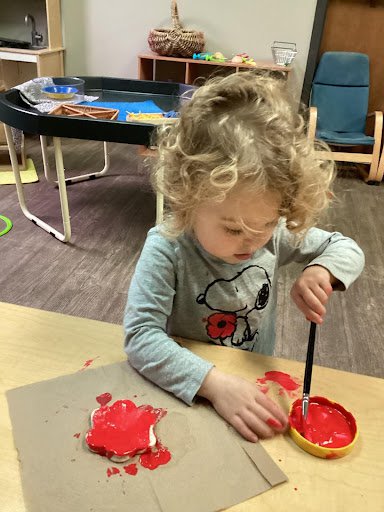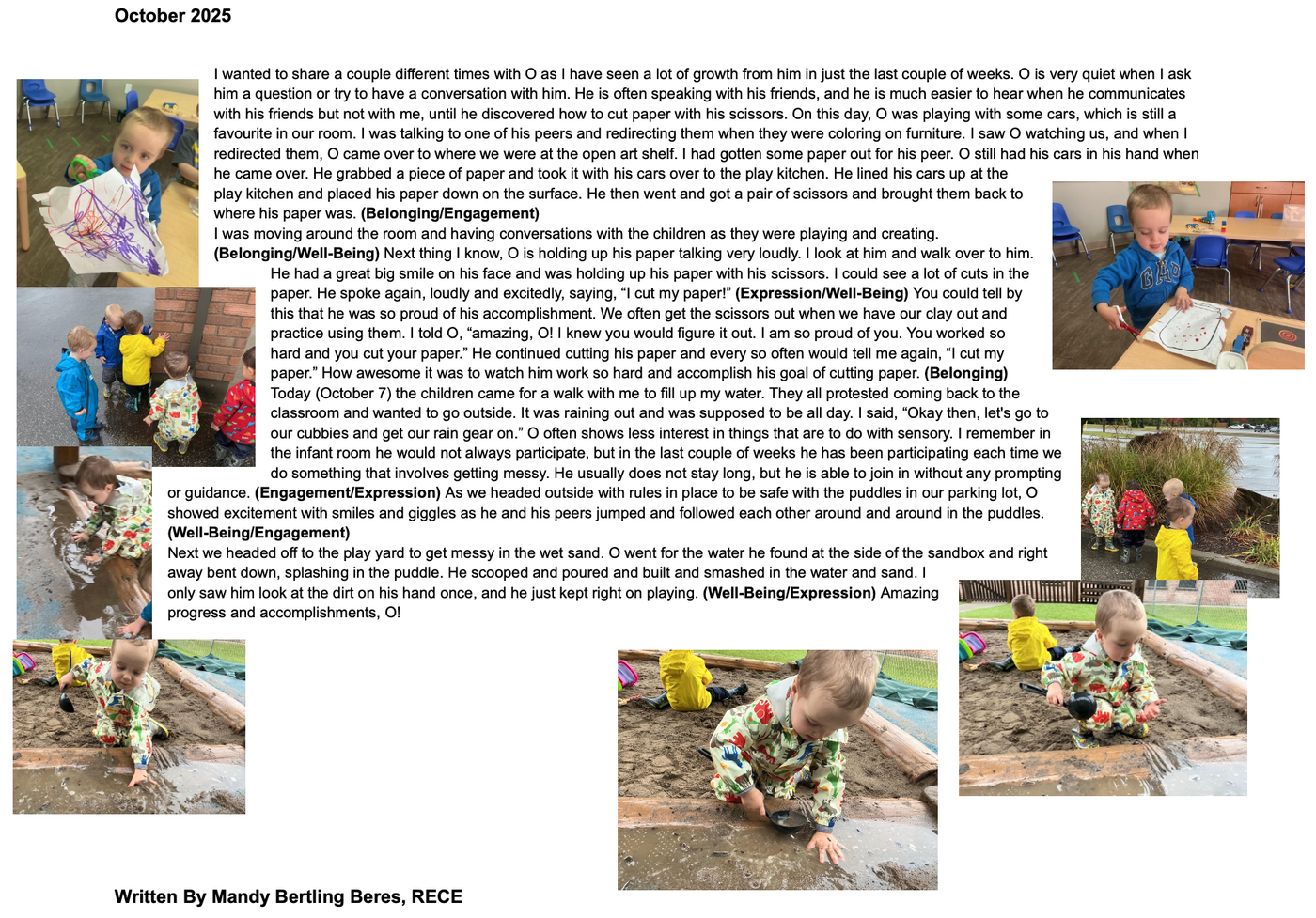
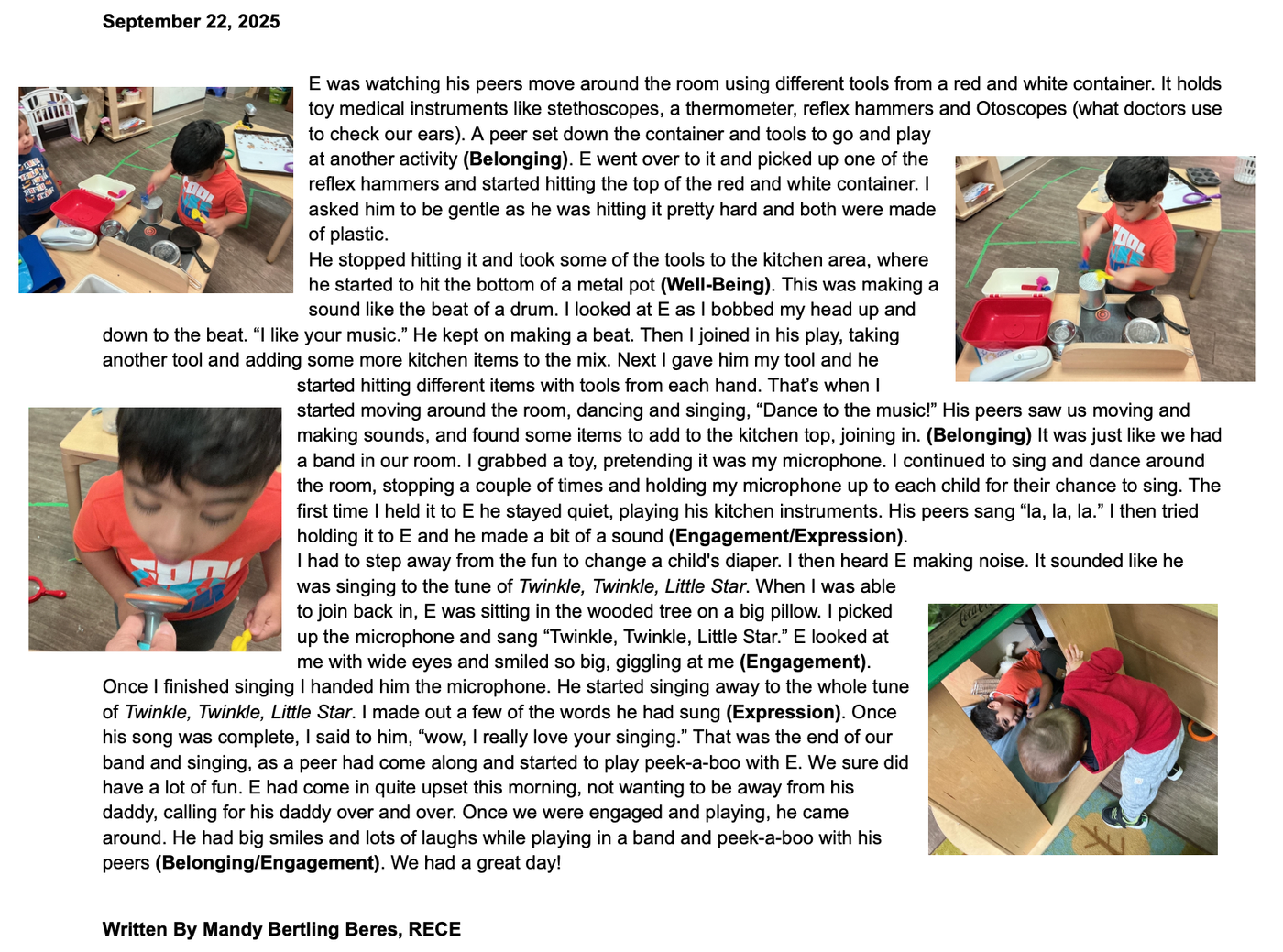
August 12, 2025
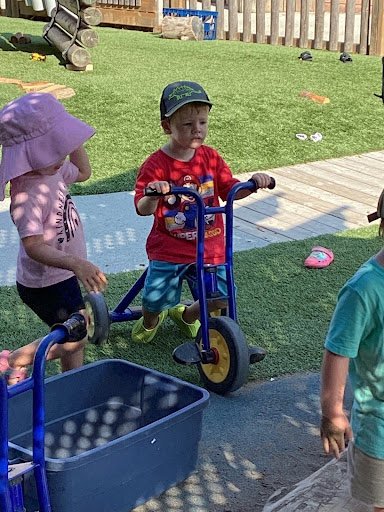
B began his play outdoors, observing his peers in play. Once a bike became available, he decided to hop onto a bike and observe his peers engaged in the sandbox. He rolled back off of the grass hill by the sandbox and went around the bike bath and came down to the gate. He turned around and as he was heading towards the bike path again, a spider crawled onto his hand. He became afraid as he called for help, “A spider, a spider!” His educator came by and said, “Where’s the spider?” and B pointed to the ground in the direction he had shaken the spider off to. I asked him, “Are you hurt? Did the spider hurt you?” and he responded, “No.” I said, “You”re ok then. The spider is going somewhere else now.” He nodded yes. A peer came over, concerned for B’s safety, and asked, “Are you ok?” B proceeded to tell him about the spider who crawled onto his hand. B even came off his bike to go with his friend to look closer at the spider. In the meantime, another peer hopped onto the bike he had put down and B didn’t seem to mind as he observed other peers in play. He then looked back and noticed his peer was on his bike. He said, “I had that bike!” His peer smiled and said, “Okay,” and got off to give him his bike back. He appeared happy as he smiled at his other friend and said, “You want to sit here?” while pointing to a spot on the bike and his friend said yes. They went around the bike track one time when his peer noticed another free bike and got off the back of B’s bike. They rode together around the bike path, smiling at one another.
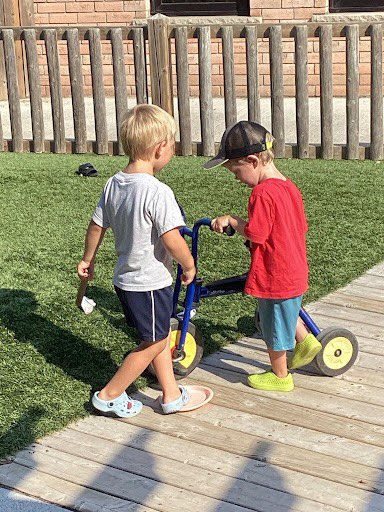
Belonging: B was able to participate in meaningful play with his peers, based on their concern for his spider incident.
Well-Being: B was physically active with his peers as they rode their bikes multiple times around the bike path. He was also able to regulate after the spider crawled onto his hand and managed his stress levels by sharing his experience with his educator and his peers.
Engagement: He was able to express his feelings to his peer who took the bike he got off of to problem solve receiving his bike back. B expressed joy as he was able to retrieve his bike and continue in play.
Expression: B started and continued conversations with his educator and peers to discuss the spider and to participate in meaningful play during outdoor time.
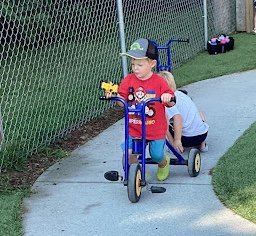
By Diane, RECE
July 2, 2025
M began his play by building a bridge with road blocks for his vehicles to cross. As he zoomed his vehicles from one side to another, he noticed a peer that was looking out the window, talking into the play phone. The educator approached his peer and asked who they were talking to, and the peer told her he was talking to Mommy. M came by, intrigued by W’s phone conversation and picked up the second phone in the classroom to call his mom as well. They both smiled as they called their mothers and the educator observed their play. The educator then showed M how to use the phone and said, “This part is for your ear to hear what Mommy is saying and this side is where your mouth is to talk to Mommy.” He looked at the phone and made sure that’s how he held it. Curious about our conversation, the other peer also looked at his phone and held it up to his ear and smiled. Another peer came rushing in and said, “I want that phone! I had it first and he took it from me!” The educator, who observed the scenario, told him, “No he didn’t take it from you, he picked it up from the shelf, but if you want a turn with that one when he’s done, I’m sure he will share.” M then hung up the phone and went to go play with the vehicles he was playing with earlier during play. The other peer who wanted that phone was now able to pick it up for his turn so he could call his mommy too. They had created a city with bridges and trees, using materials in the classroom. C looked at M and also dropped his phone to go play with the vehicle city. His peer wanted the larger red fire truck instead of the smaller cars and M and other friends chose the smaller vehicles. M was crossing the bridge with all the smaller vehicles and the other peer rushed in with his giant fire truck and shouted, “There’s a fire!” and he rode his truck through all the trees his peer had put up. Another peer came over and said, “Oh no! My trees!” and the peer paused looking at his peer in distress. The educator said, “Your friend worked really hard at adding all these trees to the city, can you help him pick them back up to put in the city?” The peer said, “Okay!” M continued to play with the vehicles on the bridge with another peer who also joined at the end just before it was time to tidy up. M was able to positively parallel play while sharing the bridge.
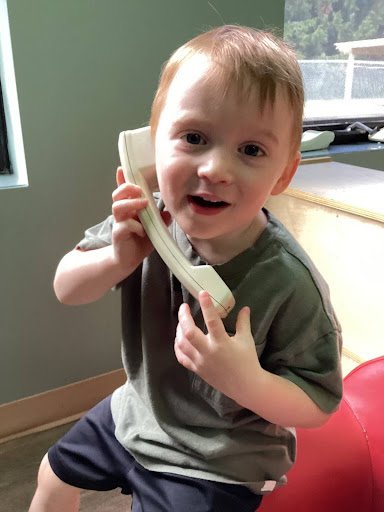
Belonging: M was able to share experiences with his peers as they all called their mothers from daycare to say hello. He felt included as they took turns with the materials and the educator showed him the proper use of the phone.
Well-Being: He was able to see that another peer wanted that phone and he was able to give it up to go back to the vehicles to give his peer the opportunity to play with that phone.
Engagement: M investigated the phone as the educator showed him where his ear goes and where his mouth goes to speak into. He also investigated the bridge to have it in the correct placement for the vehicles to cross.
Expression: He was able to collaborate and share materials on the bridge he set up for play, noticing the play city was large enough for everyone to participate.
By Diane, RECE
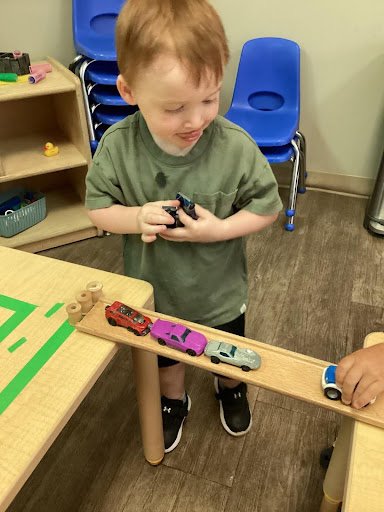
June 18, 2025
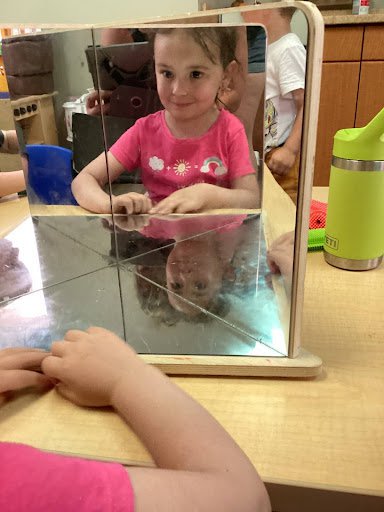
L and her peers were making their way back inside after enjoying the weather outdoors, when she noticed that the educator had set three mirrors, connecting toys and toy animals on the table as a table top activity before lunch.
The children began to play with the connecting toys and the toy animals. L immediately focused on the mirror that was on the table. She was fascinated that there were three different mirrors for her to view herself in. After a few moments of observing herself in each mirror, L began to make silly faces in the mirror to see if the silly faces would be different in each mirror. The rest of L’s peers noticed that she was having so much fun with this activity that they asked if they could have a turn with the mirror next. When all her peers were done with the mirror and it was L's turn to have the mirror again, she decided to expand on her play and began moving her hand backward and forward behind the mirror. When the educator asked L what she was doing, she responded by saying that she was trying to see if she could see her hand through the mirror on the other side. A friend then asked L if she could see the face she was making on the other side of the mirror and they began trying to guess what each other were doing behind the mirror.
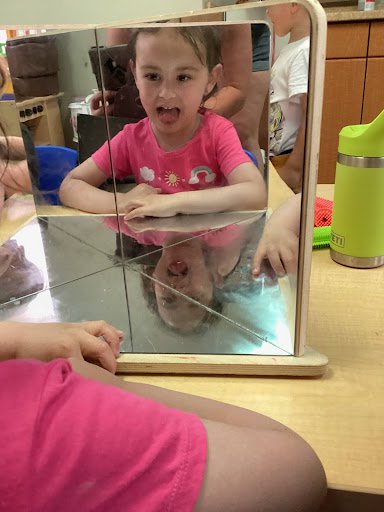
Well-being: L was further developing her sense of self when she studied her reflection in the mirror to see if it would make different facial expressions then she was making.
Belonging: L was able to participate in the activity in a way that was comfortable for herself by choosing a different toy to play with than her friends, allowing her to feel comfortable in her environment. She shared her play of the mirror with her peers, allowing her to feel more comfortable with these peers.
Expression: L was able to extend the play with her peers by putting her hand behind the mirror and engaging in a guessing game with a friend while using the mirror.
Engagement: L focused all of her attention to her different facial expressions that she was making in the mirror and continued to maintain her focus when later playing a guessing game with a friend even though other children around her were playing with different objects and trying to get her to use the toys that they were using.
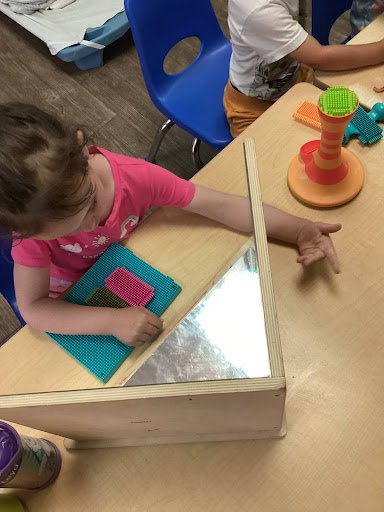
Written By Rachel Sommerville, RECE
May 26, 2025
During free play today, A placed a chair in front of a mirror in the corner of the classroom. He then made his way across the room and asked his educator to sit down in front of the mirror. “Want me to cut your hair?” he asked. His educator agreed to a pretend hair cut and A set to work. First he placed a small blanket over his educator’s shoulders. Then A picked up a small pair of pretend scissors. At first he tried with one hand but couldn’t open and close the scissors. He got a little frustrated but then switched to using both hands to open and close the scissors. While he was cutting, he stopped for a moment and asked his educator, “Does it hurt?” “No it does not,” replied his educator. Soon the hair cut was finished. Then A moved on to blow drying his educator's hair. He finished up with the pretend flat iron. “All done,” A announced. His educator said thank you and got up from the chair. By this time many of A's classmates had gathered around. He asked one of them if they would like a haircut and they excitedly agreed and sat down in the chair. A continued his pretend hair cuts until nearly everyone in the room had gotten one and it was time to clean up to go outside.
Belonging: A was able to draw from his experience at home getting a haircut and pretend to do that during play at daycare.
Well-Being: When A was using the toy scissors he got a bit frustrated that he couldn’t do it with one hand. He took a moment to calm and switched to using both hands and continued to play.
Engagement: A engaged with his peers asking if anyone wanted a pretend haircut. He communicated well and only pretended to cut the hair of the children who wanted him to. He listened to his friends and respected those that didn’t want a haircut.
Expression: Using dramatic play, A was able to communicate an experience he has had of getting a haircut.
By Brianna Wall
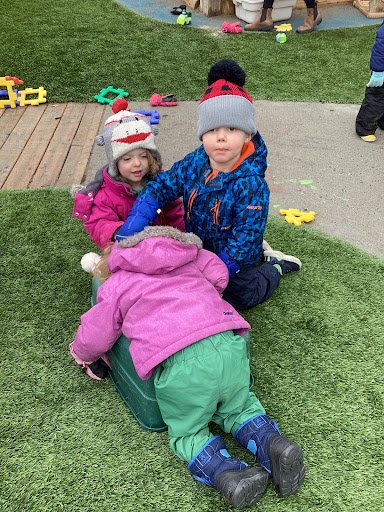
April 11, 2025
During outside time I noticed W and another peer rubbing a child’s back. I approached the children and asked, “What are you guys playing?” W was the first one to respond and said, “We are rubbing B’s back to go to sleep!" I asked, “Was she so tired?” The other child replied, “Yeah, she was.” I then asked, “Do you think she is sleeping yet?” W stood up and walked around the “sleeping child” and bent down to look at her face and said, “No, she's not sleeping. Her eyes are still open.” W then went back to where he was sitting and continued to rub the child's back. The child that was “sleeping” had her hat fall off. W had noticed her hat was no longer on her head and said, “oh no!” so he stood up and picked up her hat that had fallen off and attempted to place it back onto her head. The hat wouldn't stay on her head. W looked at me and said, “Help, B’s hat!” I replied to W and said, “Oh, is her hat not staying on? Her ears might get cold. I better help her!” W said, “Yeah, she is cold.” W went and sat down and continued to rub his peer’s back.
Well-Being: W showed a sense of well-being as he had noticed his peer’s hat had fallen off and wanted to help her so she wouldn't be cold. W showed awareness of the impact of not wearing a hat on the body.
Belonging: W showed a sense of belonging as he was engaging in pretend play with a peer from his classroom, acting out familiar routines from our nap time at daycare.
Engagement: W showed a sense of engagement as he participated in the pretend play with his peer for an extended amount of time.
Expression: W showed expression as he was the first child to respond when asked, “What are you guys playing?” showing that W was excited and eager to explain to me what he was participating in.
By Bella Vaz, RECE
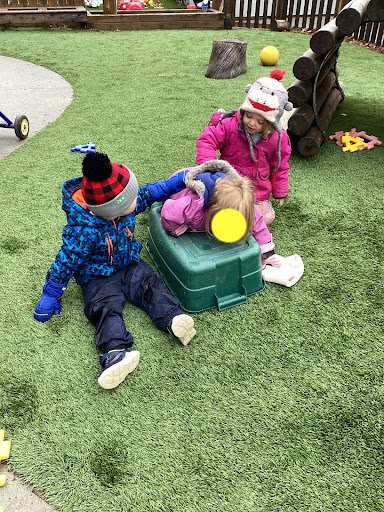
March 27, 2025
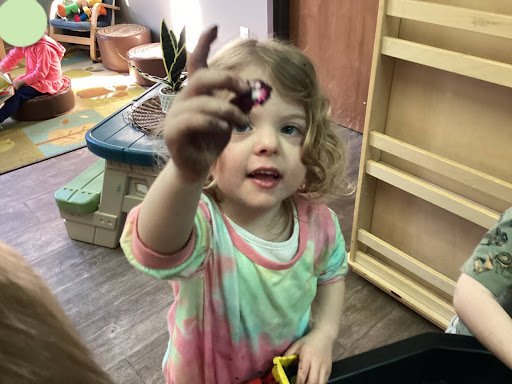
An educator asked all the children to grab a construction vehicle and come to the tuff tray. The children all quickly made their way to the tuff tray. K had found a little dump truck to bring along with her. She watched carefully as her educator placed gems all over the tuff tray then her educator dumped a whole bunch of dirt on top of the gems. K set to work right away looking for gems in the dirt. She was very excited when she found one, she held it up and said, “look a pink one!” K kept busy and found plenty of gems but then noticed something. “My hands are dirty,” she said to her educator. Her educator reassured her that when they were done they would wash their hands. As K continued to find gems, she was rubbing them in her hands to clean them. “We need to wash them,” she told her educator. “What do you need to wash them?” “Water,” said K. The educator got K a small cup of water and K began cleaning her gems in the water. Soon K’s friends noticed and liked her idea so they asked for water, too. When K and her friends had found all the gems, they helped their educator clean up the mess. Then as promised, K was able to wash her hands. She smiled and waved both her clean hands in the air. She then proudly placed all the clean sparkly gems on a towel to dry, then headed outside for more fun adventures with her friends.
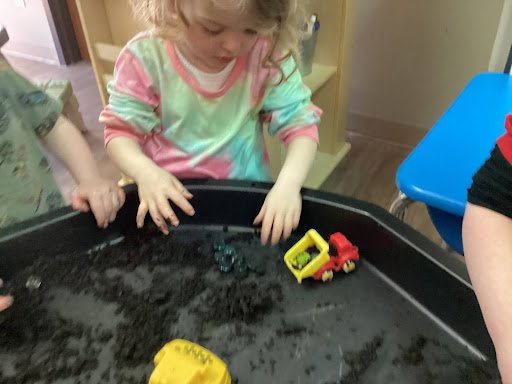
Belonging: K expressed a sense of purpose by working diligently to find all the gems in the dirt. She contributed to the program by helping to tidy up and keep her classroom clean and inviting.
Well-Being: It was clear that K was expressing her sense of competency when she asked to have water and soap so she could clean the dirt off the gems. K also did a great job managing her stress about her dirty hands, she just needed a little reminder from her educator.
Engagement: As K looked for and then cleaned all the gems, she showed focused attention. She maintained this focus during the entire activity and even when helping to clean up.
Expression: K started and continued a conversation with her educator during the gem activity. She also used her fine motor skills to clean the gems supporting her later writing abilities.
By Brianna Wall
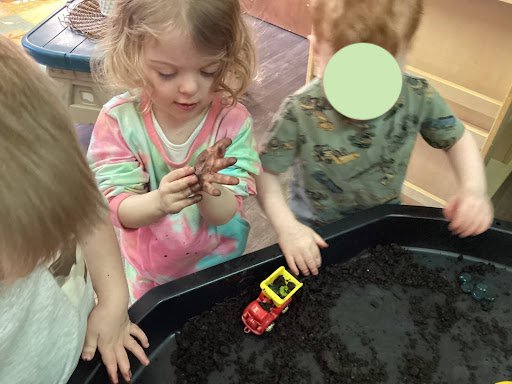
February 3, 2025
As the class was getting dressed to go outside, I told everyone, “Lets get all our stuff on so we can get outside and play on the snow hill!” T replied, “Snow hill?” I then said, “Once we are ready we will go and check it out!” T then quickly got dressed with some assistance. As we walked outside T pointed to the hill with a gasp. I opened the gate and we all started to walk over to the snow hill. Once we got to the snow hill, T was a bit hesitant to climb up. T walked around the hill observing. T walked up to me and said, “help.” I showed T how to climb up the hill. T was still hesitant about going up. I then said, “How about we make stairs to get up to the top?” T nodded “yes” and I started to pat down the snow, making indents into the side of the snow to act as stairs. When I was all finished, T then grabbed my hand for assistance and used the stairs to get up the hill. After a few times getting to the top of the hill, T was able to climb the stairs on his own and by the very end he was able to get up to the top of the hill even without the stairs as he built up his confidence in his gross motor skills. T then was playing with his peers on the top of the snow hill.
Well-being: T showed a sense of well-being as he gained confidence in his growing gross motor skills as he was able to get up on the top of the snow hill all by himself.
Belonging: T showed a sense of belonging as he was engaging in positive communication with me, his educator. T also showed belonging when was playing on top of the snow hill with his peers, showing that he feels he belongs.
Engagement: T showed engagement as he kept on trying to get to the top of the hill. T did not let his hesitations stop him from trying.
Expression: T showed expression when he gasped and pointed to the hill, showing T was excited to explore!
Written by Bella Vaz RECE
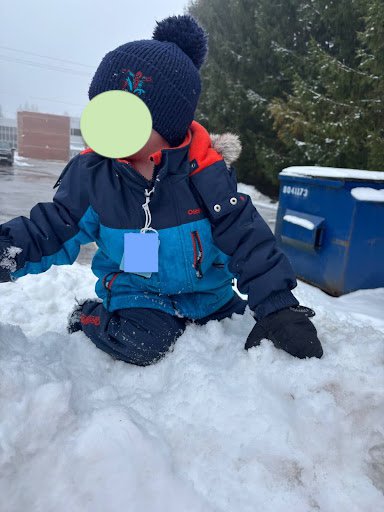
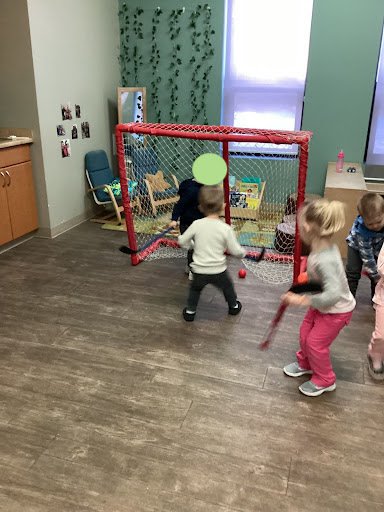
January 19, 2025
A has been talking lots about hockey. This morning A asked, “Can we play hockey?” I told A we would play hockey in the gym this morning. Moments later I realized the gym was occupied and we were unable to go to the gym. I brought the hockey net, sticks and balls into the classroom and moved the tables to the side to make room to play. A was waiting by the bucket of hockey sticks and said, “I want blue.” I gave A the blue stick. A then hit the ball with his stick and started to chase after it. Another peer picked up the ball with their hands. A shouted, "Hey, use your stick!” A then proceeded to hit the ball with his stick. A came over to me and said, “I hit a hockey player, I need a penalty.” I replied, “Okay! You can sit right here and you get one minute for roughing!” He laughed and waited. He came out of the penalty box and ran over to the ball and shot it and it went in the net! I cheered for A. He then told me, “I need to celebrate.” I said, “okay, let's celebrate!” He ran over to C and asked, “Can I have a hug? I got a goal!” C replied, “yeah,” and they gave each other a big hug to celebrate A's goal.
Belonging: A showed he felt a sense of belonging as he was eager to play hockey. A alo showed a sense of belonging as he asked me if we could play hockey today, showing he feels comfortable enough to express his wants and needs in the classroom.
Well-Being: A showed well-being as he was running after the ball and trying to shoot the ball into the net. A was engaging in physical activity which was supporting his personal well-being. He also showed pride in his accomplishment of getting a goal by wanting to celebrate with a hug from his friend.
Engagement: A showed he was engaged as he said, “I hit a hockey player, I need a penalty.” A was thinking back to his play at home and the hockey he watches at home and incorporated it into his play at daycare. This showed that A was engaged in his play by making real world connections.
Expression: A showed expression when he said “I want blue” this was A expressing he likes the colour blue.
Written by Bella Vaz RECE
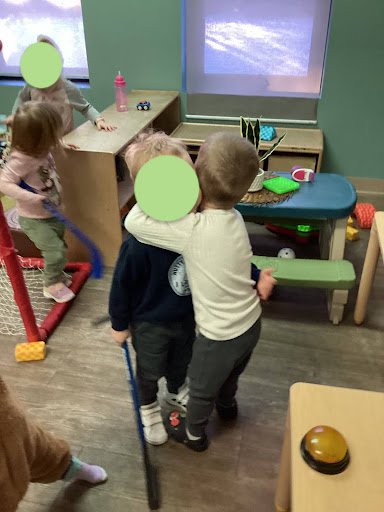
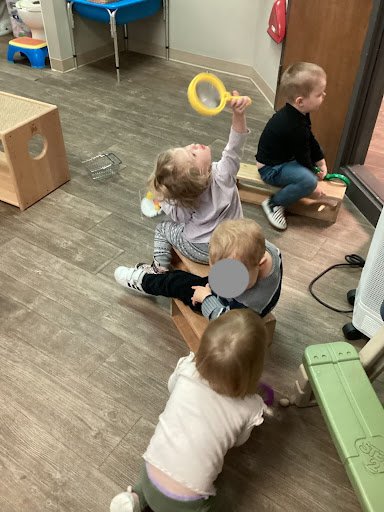
Dec 04, 2024
A boy and his peers were sitting on each of the wooden blocks and he shouted, “Let’s go, choo choo train!”
He started to move, pushing his feet forward and the other kids followed.
Once he reached the classroom door, he looked at Ms. Youngmi smiling. The educator reminded him to stay in the classroom so the boy stopped moving and closed the door.
His peers were right beside him, connected as a train, and they started to play.
He was looking around at his peers and the classroom with a magnifying glass, saying, “Youngmi! I see you!” and then turned to his peer right behind him saying, “I see you!” They looked at each other, giggling together.
After taking the time to browse and talk, another peer shouted, “W, move!”
He shouted back, “Let’s go! Choo choo!” moving forward and leading the train to follow.
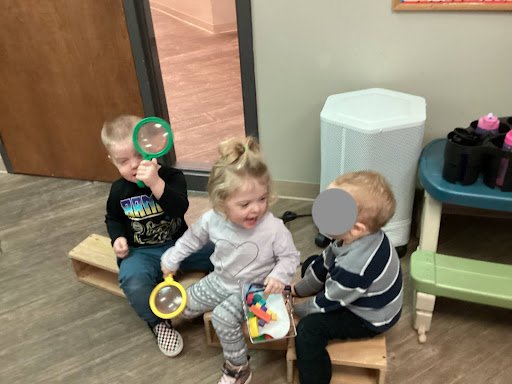
Belonging: The boy felt a sense of belonging when he led his peers in his dramatic play of a train and engaged in the play, too. He showed positive leadership during his playing and communicating.
Engagement: He enjoyed moving forward using his legs and feet muscles on the wooden block and verbally interacting with the educator and peers.
Well-being: He showed excitement and confidence while playing by expressing his ideas to the peers and the educator, giggling and smiling at people around him. He knows the boundary of the playing area and keeps himself in the classroom.
Expression: He was able to talk about his creative idea for dramatic play and get the peers' and educator’s attention by leading the play in front of the group.
Written by Youngmi Kang, RECE
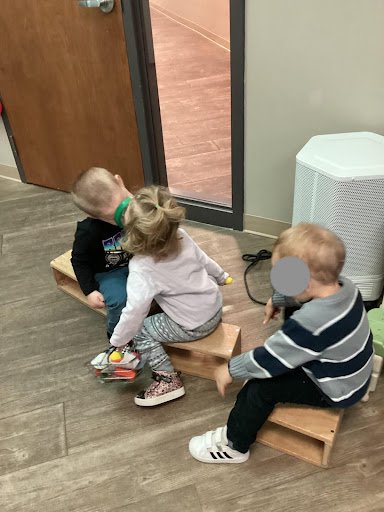
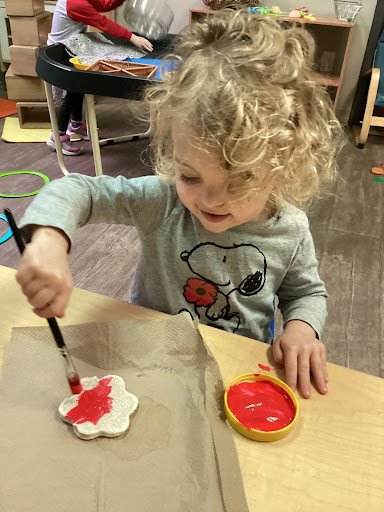
Nov 11, 2024
While playing with a peer, the girl listened to Ms.Youngmi ask the class, “Who wants to paint?” She shouted, “me!” coming to the table.
She sat at the table and saw a flower shaped salt dough that she made the other day.
The educator started to talk to the class, “Do you remember this? It’s a poppy for Remembrance Day,” showing the poppy on her shirt. The girl touched her poppy, too, on her shirt while staring at the educator. She grabbed a brush to paint her poppy and said, “red!” After painting all over the poppy, she shouted, “I’m done!” The educator praised her. “Your poppy looks red now!” She smiled. “Do you see in the middle of your poppy? What colour is that?” asked the educator and the girl said, “Black!” Then she grabbed another brush with black paint to place a dot on the middle of her poppy.
Belonging: The girl felt a sense of belonging when she interacted with the educator by talking about the special day and the colours she knows. She saw the poppy on her shirt as well as the other peers and the educator for Remembrance Day and was able to get a feeling of being included.
Engagement and Expression: She engaged in the conversation about the poppy and Remembrance Day. She was able to recognize her salt dough poppy that she made the other day and enjoyed colouring it red and black in the middle.
Well-Being: She was able to show her motor skills while painting with a brush. She showed confidence in talking about the colour of the poppy and took initiative to finish her own artwork.
Written by Youngmi Kang, RECE
